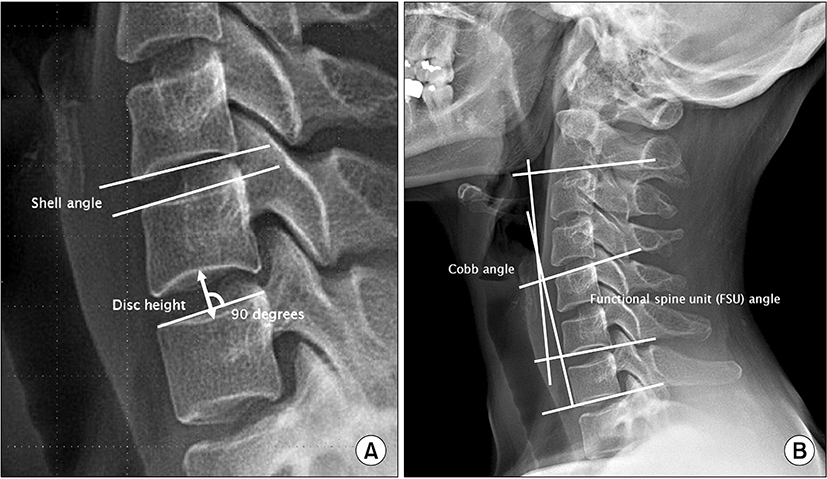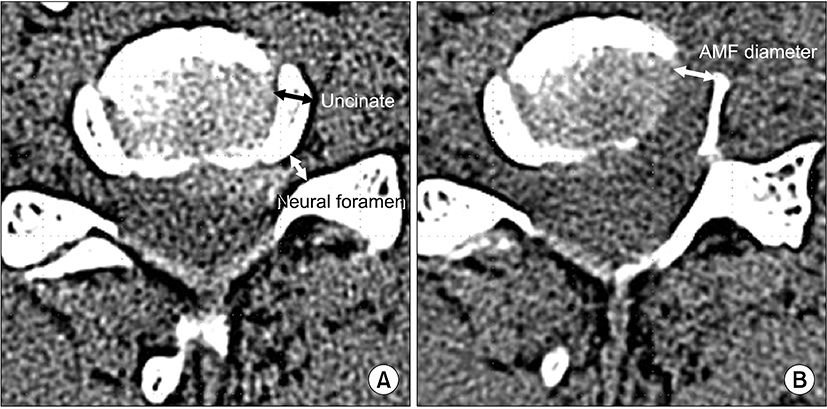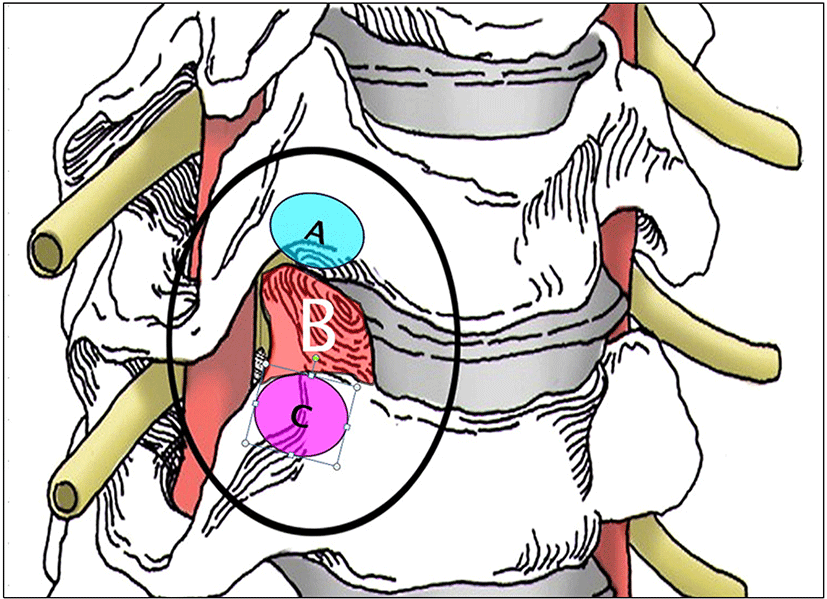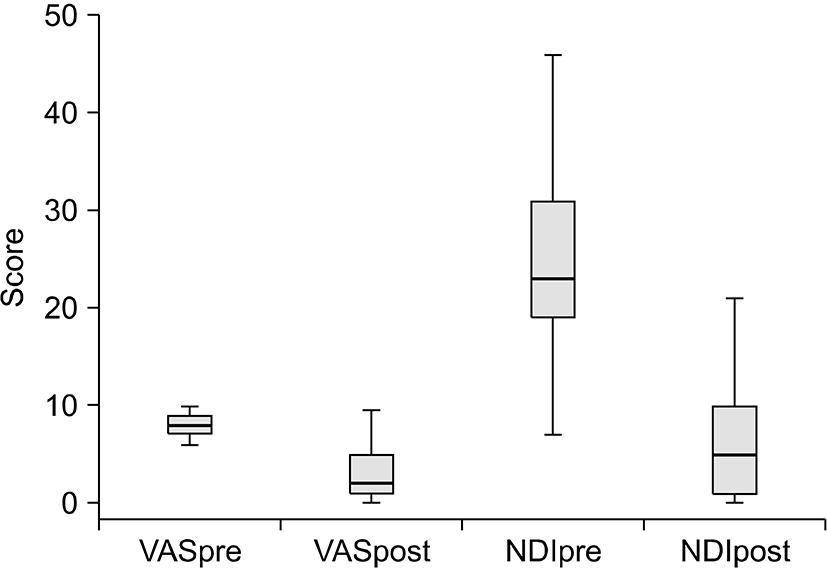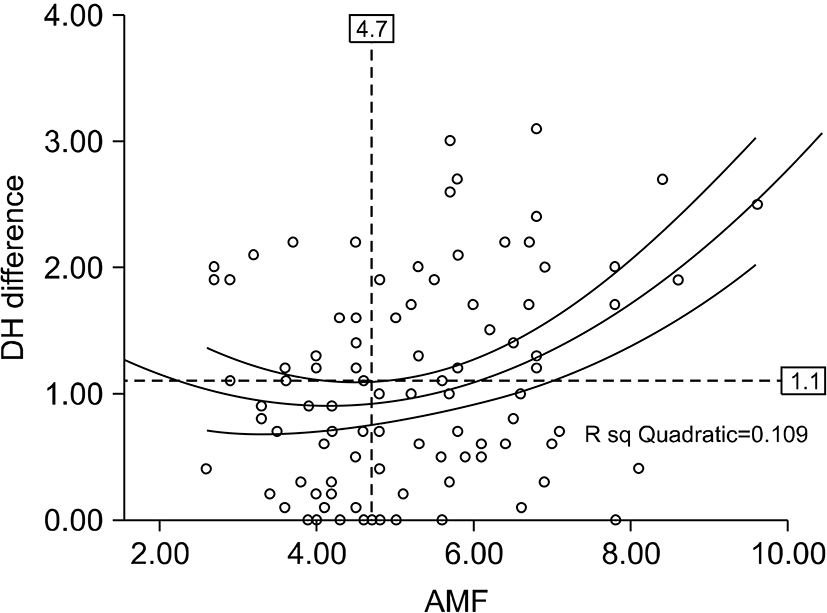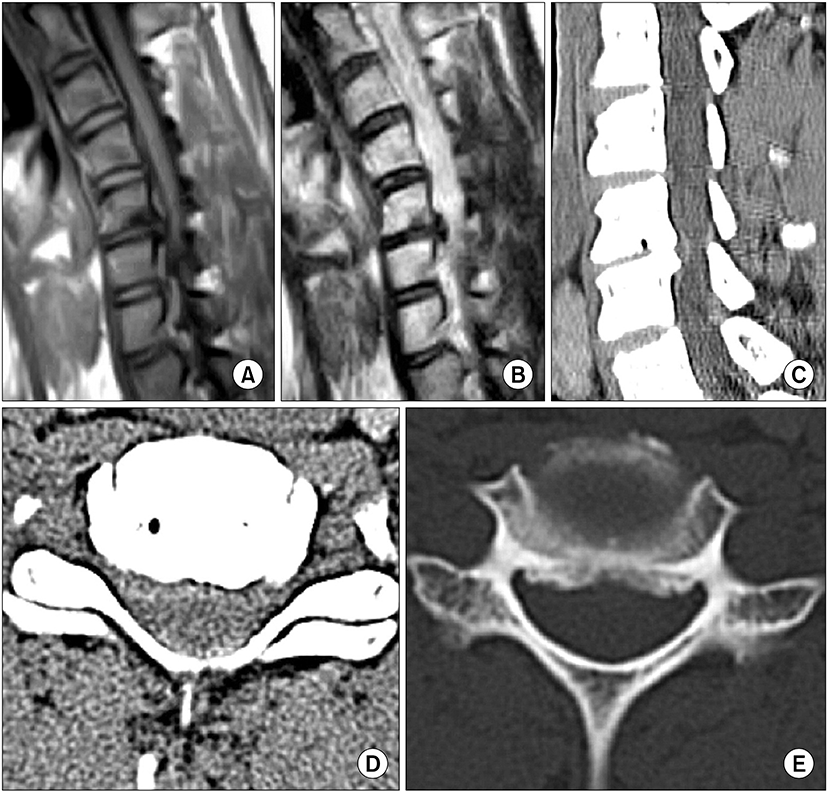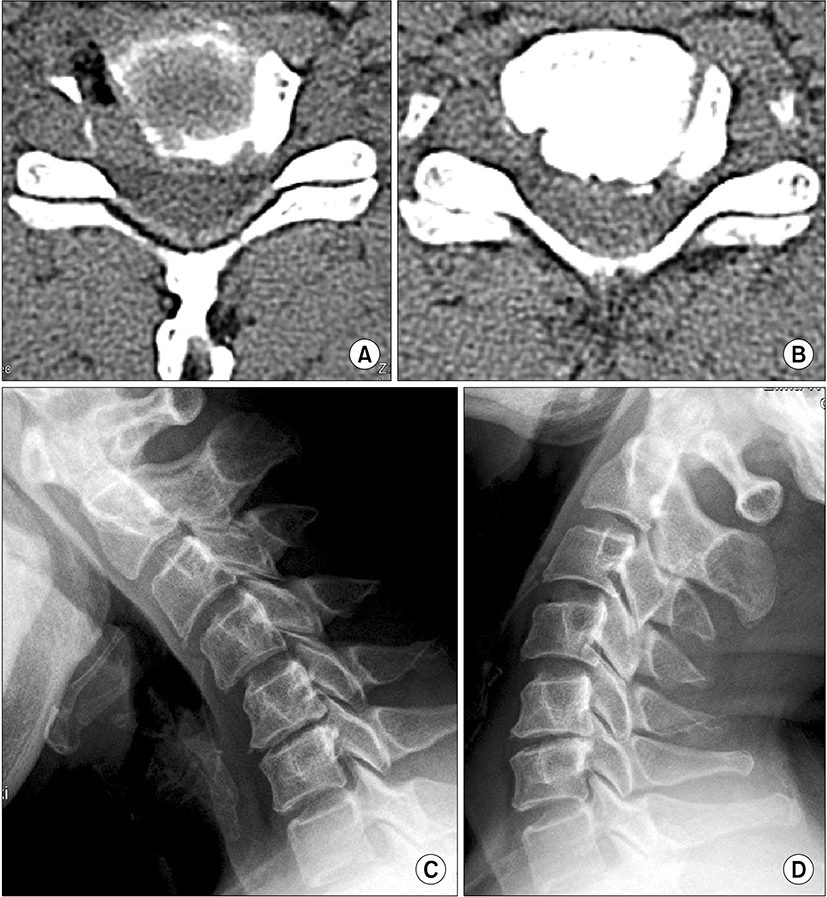서 론
전방경유골유합술은 경추부 퇴행성 질환에 대해 가장 많이 시행되는 수술법이지만[1-6], 수술 후 운동관절의 소실로 인해 인접부에 퇴행성변화를 가중시킨다고 알려져 있다[7-13]. 이러한 점을 개선하기 위해 1968년 Verviest [14]는 경추측면접근법(lateral approach)을 제안하였고, 1976년 Hakuba [15]는 구상돌기 부위의 디스크를 통한 접근법(transuncodiscal approach)을 제안하였다. 하지만 모두 수술적 노출이 심하고, 적어도 일부에서는 골유합이 필요하거나 수술 후 골유합이 진행되었다. 1989년 Snyder와 Bernhardt [16]는 전방경유경추디스크를 통한 감압술(anterior cervical fractional interspacedecompression)을 제안했으나 이는 결국 부분적인 전방경유디스크절제술이었다. 1996년 Jho [17]는 운동 관절을 유지하면서 신경공주변의 병변만 제거하기 위해 전방경유미세신경공확장술(anterior microforaminotomy, AMF)을 개발했다. 이후로 많은 저자들이 이 수술을 시행하고 좋은 임상 결과들을 발표한 바 있다[18-27]. 일부 저자들은 AMF 후 방사선학적 관찰을 시행하여 수술 후 가중된 퇴행성 변화의 지표인, 해당 분절의 디스크 높이가 감소함을 발견하였다[21]. 그러나 추적 관찰이 짧고, 광범위한 분석이 이루어지지 않아 정확하게 어떠한 요소가 디스크 높이를 감소시키는지, 어떻게 하면 이를 피할 수 있는지 알려지지 않았다. 이에 저자는 이 수술을 시행받은 충분한 수의 환자를 대상으로 장기적인 관찰을 하여 해당 분절의 디스크 퇴행성 변화를 가중시키는 인자들을 연구하였다.
방 법
본원에서는 2000년 9월부터 2011년 8월까지 11년간 232명의 퇴행성 경추부 질환 환자에 대해 272예의 AMF를 시행하였다. 수술 대상은 6주 이상의 보존적인 치료에도 호전되지 않고, 임상증상이 CT, MRI로 확인된 병변을 가진 환자들이었다. 이 중에서 전에 경추부 수술을 받지 않았고, 척수병증을 보이지 않았으며, 경추부의 다른 수술을 시행받지 않았고, 3년 이상 임상적, 방사선학적으로 추적관찰이 가능했으며, 마지막 관찰 시 자료분석에 동의하고 임상적, 방사선학적 검사를 시행 받은 82명을 대상으로 하였다. 이중 71명(86.6%)에 대해서는 한 개 분절만 수술하였고, 10명(12.2%)에 대해서는 두 개 분절을 수술하였으며, 1명(1.2%)은 세 개 분절에 대해 수술을 시행하여 모두 97예의 수술을 시행하였다. Table 1은 이 환자들의 수술 전 임상상태와 수술을 시행한 분절수를 보여주고 있으며, Table 2는 수술한 분절의 병변 종류와 부위를 보여주고 있다. 이들은 남자 56명, 여자 26명이었으며, 수술 당시 평균연령은 48.4세(범위, 31∼76세)였다.
임상적인 분석은 입원 및 통원 기록지를 분석하였고, 방사선학적 결과는 PACS 자료를 분석하였다. 입원 당시 visual analog scale (VAS)과 neck disability index (NDI) 점수를 포함한 수술 전 증상과 증세를 확인했고, 수술 후에는 퇴원 당시와 이후 2주마다 한번씩 통원 관찰을 하여 3개월간 및 수술 후 1년에 확인하였으며, 본 연구가 시행될 시기에 마지막으로 설문지와 전화를 통해 VAS와 NDI 점수를 얻었다. 방사선학적 검사는 수술 전 모든 환자에서 역동적 검사를 포함한 단순방사선촬영과 고해상도 CT, MRI를 시행하였고, 수술 후 AMF 범위를 확인하기 위한 고해상도 CT를 시행하였으며, 수술 후 3개월 동안 매 2주마다 역동적 검사를 포함한 단순방사선촬영을 시행하였고, 마지막으로 연구시작 시 시행하였다. PACS workstation (Starpacs 5.0.8.1; Infinite, Seoul, Korea)을 이용하여 수술 후 CT에서 AMF 크기를 얻었고(Fig. 1), 수술소견에서 디스크 침범 여부를 확인하였으며, 수술 전후 단순촬영에서 해당 관절의 Cobb angle, functional spine unit (FSU) angle, shell angle (SA), 그리고 디스크 높이를 측정하였고(Fig. 2), 역동적 촬영에서 각각도의 운동범위를 측정하였다. 통계적인 분석은 SPSS ver. 15.0 (SPSS Inc., Chicago, IL, USA)를 이용하였다.
AMF는 세가지 접근법으로 세분되는데 저자는 이중구상돌기를 통한 접근법을 시행하였다(Fig. 3) [22]. 기관 삽관을 통한 전신마취 하에 누운 상태에서 수술이 시행된다. 머리는 정중앙에 똑바로 위치시키고, 양 어깨는 수술 중 방사선 촬영이 용이하게 접착테이프를 이용하여 잡아당겨 수술대에 고정한다. 수술부를 포함한 경부 전면을 소독하고 수술부만 노출한 뒤 소독포를 덮는다. 환측에 중앙에서 3 cm 목의 피부선과 평행하게 절개하고, 피하 조직과 광경근을 동일하게 절개한다. 목빗근과 경동맥의 내측, 기도와 식도의 외측 사이를 박리하여 경추전면을 노출한다. 정확한 수술부를 방사선으로 확인하고, 통상적인 경추견인기를 위치하여 환측 longus colli 근육의 전면을 확인한다. 수술현미경을 위치하고, 해당 추간판의 상하경추횡돌기의 근위부를 노출하여 구상돌기관절을 확인한다. 제6∼7 경추간 수술 시에는 척추동맥이 lonus colli 근육 아래, 제7경추횡돌기 위에 위치하여 주의를 요한다. 상하횡돌기 사이에 위치한 구상돌기관절을 고속드릴을 사용하여 구멍을 만든다. 이때 경추의 측면에서 1∼3 mm 사이에 존재하는 척추 동맥의 손상을 예방하기 위해 구상돌기 외벽을 얇게 남기고 후종 인대가 드러나면 후에 이 외벽을 제거해낸다. 구상돌기의 외벽을 제거하면 신경근의 압박이 풀리는 것을 확인할 수 있고, 만일 병변이 척추증이라면 여기서 수술은 끝날 수 있다. 파열된 디스크는 후종인대를 부분적으로 열고 제거할 수 있다. 잔존하여 신경근을 압박할 수 있는 뼈나 인대를 모두 제거하여 신경근이 완전히 감압되는 것을 확인한 후 수술을 끝낸다. 광경근과 피부는 통상적인 방법으로 봉합하고 경부 보조구는 착용하지 않는다.
결 과
저자는 본원에서 11년간 경추부 퇴행성 질환을 가진 환자 232명의 272분절에 대한 AMF를 시행하였으며, 이 중 82명의 97분절에 대해 이 연구를 시행하였다. 82명의 환자에서 추적 관찰 후, 59명(72%)은 Odom’s 기준상 뛰어난 결과를 보였고, 15명(18.3%)은 좋은 결과를 보였으며, 6명(7.3%)은 적정한 결과를 보였고, 2명(2.4%)은 호전되지 않았다(Table 3). 수술부가 1개 분절인 경우는 71명(86.6%), 2개 분절인 경우는 10명(12.2%), 그리고 3개 분절인 경우는 1명(1.2%)이었다(Table 1). 주된 병변은 경추증이 52예(53.7%), 추간판탈출증이 35예(36%)였으며, 나머지 10예(10.3%)는 두 병변이 공존하는 상태였다. 수술한 분절은 제5∼6 경추간 병변이 50예(51.6%), 제6∼7 경추간 20예(20.6%), 제4∼5 경추간 19예(19.6%), 그리고 제3∼4 경추간 8예(8.2%)였다(Table 2). 환자의 연령을 보면 40대 33명(40.2%), 50대 26명(31.7%), 30대 14명(17.1%), 60대 7명(8.5%), 그리고 70대가 2명(2.4%)이었다. 수술로 인한 합병증은 없었으며, 재수술은 2명에서 시행되었다. 둘 다 수술 후 1개월 이내에 방사통이 재발하여 재수술을 시행하였고, 수술 시 침범된 추간판에서 작은 디스크 조각이 돌출하여 신경근을 압박하는 소견을 보였다. 평균 추적기간은 6.1년(범위, 3.1∼8.0년)이었다.
평균 VAS 점수는 수술 전 8.2에서 수술 후 2.9로 호전되었으며, NDI 점수도 수술 전 24.5에서 수술 후 6.7로 통계적으로 유의하게 호전되었다(P>0.01) (Fig. 4). 이러한 수술 전후의 VAS, NDI 점수나 그 변화는 연령, 성별, 수술 부위, 수술 전 퇴행성 변화여부, AMF 크기, 수술 전후의 추간판 높이 변화, 다양한 각도 변화 및 운동범위와 무관하였다. 수술 중 디스크 침범은 64예(65.9%)에서 보였다.
평균적인 AMF 크기는 5.2 mm (범위, 2.6∼9.6 mm)였으며, AMF 크기는 디스크 침범, 수술 후 추간판 높이 감소와 유의한 상관관계를 보였다(P<0.05). 디스크 침범이 있는 경우에는 수술 후 추간판 높이 감소는 물론이고, 수술 후 FSU와 SA 각도 및 FSU의 운동 범위 등의 감소, 수술 분절의 전방 골극 변화발생에 의미 있는 차이를 보였다(P<0.05). 수술 전 추간판 높이는 5.8 mm (범위, 1.9∼8.4 mm)였으며, 수술 후 추간판 높이는 4.7 mm (범위, 1.0∼7.1 mm)였고, 수술 전후의 추간판 높이 감소는 평균 1.1 mm (범위, 0∼3.1 mm)로 유의한 수술 전후 차이를 보였다(P<0.01). 16예(16.5%)에서는 추간판 높이 감소가 없었고, 3예에서는 50% 이상의 추간판 높이 감소를 보였다. 수술 후 추간판 높이가 감소하면 FSU, SA, 그리고 FSU의 운동 범위가 감소하였다(P<0.05). AMF 크기와 수술 후 추간판 높이 감소의 상관관계 도표를 그려서 추세선을 확인하여 결정적인 AMF 크기는 4.7 mm임을 추정할 수 있었다(Fig. 5). 환자군을 AMF 크기 4.7 mm를 기준으로 하여 두 군으로 나누면, 두 군 사이에 수술 중 추간판 침범 여부, 추간판 높이 감소, 그리고 SA 각도가 유의한 차이를 보였다(P<0.05). 두 군간에 수술 전후 전체 경추부 각도나 해당 분절의 각도 및 각운동 범위의 차이는 없었다. 수술 전후 Cobb, FSU, SA 각도는 유의한 차이가 없었으며, 각각도의 운동 범위도 유의한 차이가 없었다(P<0.05). 추적 검사상 측만증이나 굴곡 변형을 보인 예는 없었다.
전형적인 예를 소개하면 다음과 같다.
51세 여자가 내원하기 3개월 전부터 우측 제6신경근 지배부의 방사통을 주소로 내원하였다. 신경학적 검사상 운동 약화나 건반사 감소는 없었으며, 우측 엄지와 검지의 감각 저하와 이상 감각을 보였다. 수술 전 CT, MRI에서 우측 제5∼6 경추간 추간판 돌출과 경추증이 공존하며 신경근을 압박하는 소견을 보였다(Fig. 6). 저자는 우측으로 접근하여 제5∼6 경추간 4.5 mm 크기의 AMF를 시행하였다. 수술 중 AMF 내측에서 일부 추간판 침범이 있었다. 수술 중 신경근 감압이 확인되었고, 수술 후 방사통과 감각증상은 바로 호전되었으며, CT에서 신경근 감압이 확인되었다. 5년 추적 검사상 추간판 높이는 수술 전의 5.8 mm에서 4.2 mm로 감소하였다. 이차적인 경추 불안정, 후만-측만 변형, 또는 골극 변화는 없었으며, 경추 운동 범위는 잘 유지되었다(Fig. 7).
고 찰
저자와 동일한 방법으로 수술을 시행한 대부분의 저자들은[17,18,20-24,28] 수술 후 91%에서 99%의 환자에서 임상 증상의 호전을 보였다고 보고하였으며, 한 저자는 단지 52%에서만 호전을 보였다고 하였다[29]. 그러나 이 연구들은 모두 상세한 방사선학적 결과가 결여되어 진정한 수술 결과라고 하기에는 미흡했다. 본 연구에서는 90.3%의 환자에서 임상 증상의 호전을 보였으며, VAS와 NDI 점수는 97.6%에서 유의한 호전을 보였다. 방사선학적 결과에서도 수술 후 추가적인 변형없이 해당 분절이나 경추 전반에 걸쳐 정적인 모양이나 운동 범위가 잘 유지되는 모습을 보였다. 지금까지 발표된 합병증은 7% [22]에서 22% [29]였으나 본 연구에서는 4.9% (2예)의 추간판 재발로 인한 재수술 외에는 합병증이 없었다.
신경공확장술로 인해 손상되는 구상돌기-척추간 관절은 경추 불안정과 운동에 있어서 상당히 중요할 수 있다. Kotani 등[30]과 Chen 등[31]은 사체에서 얻은 경추 분절을 이용하여 구상돌기-척추 관절을 제거한 후 생역학적 실험을 하고, 신경공에 접한 후방부위가 해당 분절의 안정성과 운동성에 중요하다고 하였다. Hacker와 Miller [29]는 23명의 환자에서 신경공 확장술을 시행하여 30%의 환자에서 추가적인 수술이 필요했으며, 단지 12명에서만 좋은 결과를 얻을 수 있었다고 하였고, 구상돌기-척추 관절의 제거가 지나친 운동성을 초래하여 불안정하고 통증을 유발하게 된다고 하였다. 본 연구에서는 신경공 확장술 크기가 4.7 mm 이상이거나 수술 시 추간판 침범이 있는 경우에는 해당 분절의 각도 변화만 상관관계를 보였고, 이로 인해 1 mm가 넘는 추간강 감소가 있었던 경우에만 수술 후 해당 분절과 경추 전반의 각도 변화와 상관관계를 보였다.
신경공확장술을 시행하여 추적 관찰한 학자들은 수술 후 환자 모두는 아니더라도 추간판의 높이가 감소하는 경우를 발표하였다[21]. 추간판의 높이 감소는 수술 후 해당 분절의 추간판에 퇴행성 변화가 가속화됨을 의미한다. 이러한 변화는 추간판의 기능 저하와 운동성 감소를 초래할 수 있다. 하지만 수술 시 어떠한 인자가 추간판 높이 감소에 관여하는지에 대한 연구는 없었다. 본 연구에서 조금이라도 추간판 높이가 감소한 경우는 수술을 시행한 총 97분절 중 81분절(83.5%)였고, 평균적인 추간판 높이 감소는 1 mm였다. 신경공확장술의 크기와 추간판 높이 감소의 상관 관계 그래프를 분석하여 추세선을 이용하면 신경공확장술의 크기가 4.7 mm를 넘으면 신경공확장술 크기에 비례하여 추간판 높이가 감소하였다. 신경공확장술 크기 4.7 mm를 기준으로 두 군으로 나누었을 때 두 군간 추간판 높이의 감소와 디스크 침범 여부에 있어서 의미있는 차이를 보였으나, 수술 전후 전체 경추부 각도나 해당 분절의 각도 및 각운동범위의 차이는 없었다.
경추부의 퇴행성 변화가 진행하면, 추간판의 변성 변화, 추간강 감소, 추체골극 변화, 연골판의 경화증, 후방으로 추간판 돌출, 경막의 압박, 그리고 신경공의 협착이 발생한다[32,33]. 수술 시 추간판에 작은 손상이 발생할 경우에도 이러한 퇴행성 변화가 발생할 수 있다. Osti 등[34]은 양에서 추간판에 실험적 손상을 준 후 시간 경과를 두고 관찰하여 추간판이 급격하게 퇴행성 변화를 보이고 1∼18개월에 걸쳐 추간판 높이가 감소하는 것을 발표하였다. Nassr 등[11]은 수술 시 정확한 수술 부위를 확인하기 위해 추간판에 바늘을 찌르는 것 조차 추간판 퇴행성 변화를 초래할 가능성이 3배 정도 증가한다고 하였다. 본 연구에서 수술 시 추간판 침범이 있는 경우는 97분절 중 64분절(67%)이었으며, 추간판침범이 있는 경우, 없는 경우에 비교하여 수술 후 추간판 높이 감소는 물론이고, 수술 후 FSU와 SA 각도 및 FSU의 운동 범위 등의 감소, 나아가서는 수술 분절의 전방 골극 변화 발생에 의미있는 차이를 보였다. 이는 신경공확장술의 크기도 중요하지만 신경공확장술의 크기와 관계없이 수술 시 추간판을 침범할 경우 해당 분절의 퇴행성 변화가 뚜렷하게 나타난다는 것을 의미한다.
신경공확장술은 경추부 퇴행성 질환에 대한 안전하고, 효과적인 치료법이다. 하지만 수술 후 장기적인 관찰시 추간판 높이가 감소하여, 이로 인해 일련의 퇴행성 변화가 유발될 수 있다. 따라서 장기적으로 좋은 수술 결과를 얻기 위해서는 가능한 한 그 크기를 작게하고, 추간판 침범을 피해야 한다.

